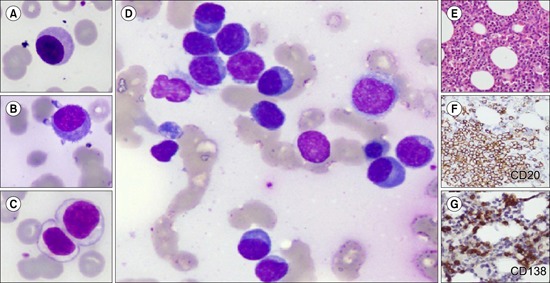
A 56-year-old man presented with generalized weakness, weight loss, rib pain, and an 8-cm palpable splenic mass. Blood examination revealed hemoglobin, 6.6 g/dL; white blood cells, 10.3×109/L; absolute lymphocyte count, 7.4×109/L; and platelets, 61×109/L. Peripheral blood film displayed rouleaux formation, and numerous small lymphocytes admixed with a variable number of plasmacytoid lymphocytes (A-C). Similar findings were observed in the bone marrow aspirate (D). Bone marrow biopsy showed interstitial and paratrabecular infiltration by CD20-positive plasmacytoid lymphocytes and CD138-positive plasma cells (E-G). Immunophenotyping showed B cell-associated antigens (CD19, CD20, CD22, cCD79a), immunoglobulin M (IgM) lambda light chain restriction and CD138-positive plasma cells (16%). Serum IgM level was 117.04 g/L. Lymphoplasmacytic lymphoma (LPL) with Waldenström macroglobulinemia (WM) was diagnosed. One week after the second cycle of rituximab, cyclophosphamide, vincristine, and prednisone, he presented to the emergency room because of confusion and aphasia. Serum IgM level was 100.03 g/L. Suspecting either hyperviscosity or a flare reaction to chemotherapy, he underwent two cycles of plasmapheresis. Gradually, he recovered, and was discharged. A substantial subset with LPL demonstrates IgM monoclonal gammopathy or WM. Patients with significantly elevated IgM levels should be treated with plasmapheresis or cytoreductive therapy before rituximab treatment.




 PDF
PDF ePub
ePub Citation
Citation Print
Print


 XML Download
XML Download